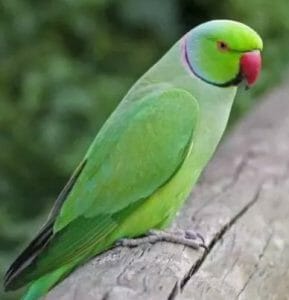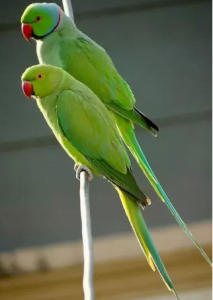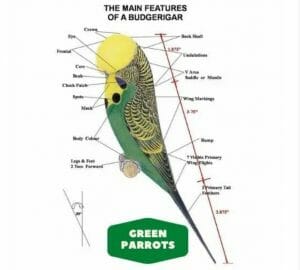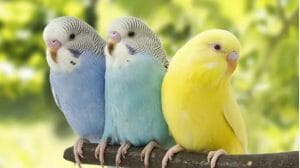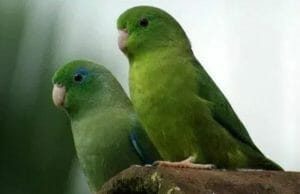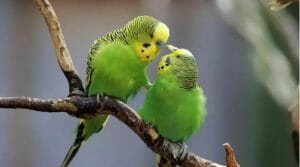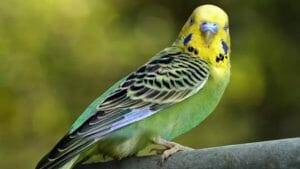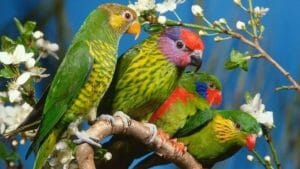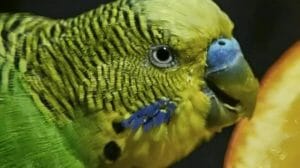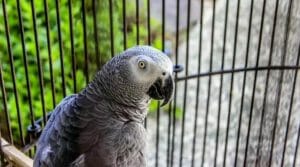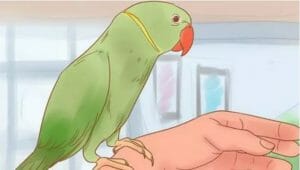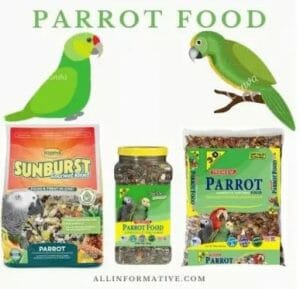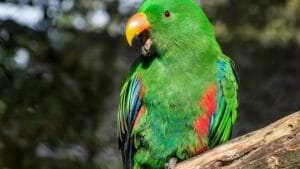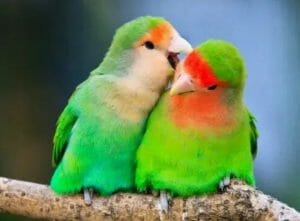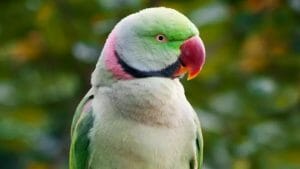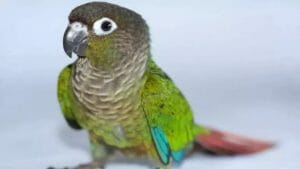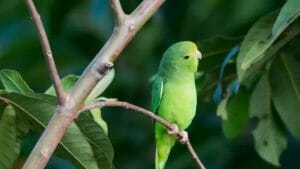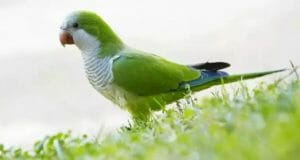A strong yellow Green Parrot that is yellower and duller than viridine, Yellow, Duller and slightly yellower than love bird. They called also parrakeet, perruche, popinjay green and verd gay. Here, We discuss about Green Parrot | Guide for Green Parrots to Keep as Pet.
Contents
Green Parrot:
Green is a dominant color in many parrot species around the world. Including those frequently kept as pets. Some Green Parrots have additional bright colors mix into their plumage. While others have more subtle markings. These birds are intelligent and full of personality. They require a committed caregiver.
The Green Parakeet is a medium size parrot occurring in North and Central America from southernmost tip of Texas south to northern Nicaragua. The bird is 32 cm in length and mostly green in color. It also has yellow beak. The bird feeds on seeds, various fruits and corn. It can sometimes be consider crop pest.
Wild birds primarily use scrub, swamp forests, woodlands and forest clearings. The US population takes advantage of palm groves in cities. This species was formerly place in genus Aratinga as A. holochlora. It divided into various subspecies. Later, it was split into three species as green conure, pacific conure, and Socorro conure.
Today it is recognize as single species with highly threatened subspecies endemic to Socorro in Revillagigedo Islands, Mexico. Green parakeet pairs usually find holes in trees in which to nest. Where female lays three or four eggs. It also nests colonially in crevices on cliff faces. After breeding season is complete, birds form large communal roosts.
Budgie Green Parrot:
The little budgie bird is one of most popular pets in world. It’s ranking just behind dogs, cats and it’s no wonder. This affectionate, cute bird is small and inexpensive. If trained properly budgie can mimic human speech. The origin of its formal name budgerigar is mystery. But by any name, this little bird is charming companion for most pet owners.
Budgies:
Budgies aren’t all fun and games. Though, so before you bring one home. Make sure you’re not in for any surprises. Here are some key things to know about budgie birds. All Budgies Are Parakeets But Not All Parakeets Are Budgies.
Some people refer to budgies by their full name and some call them parakeets. But while budgies are parakeets. There are many different types of parakeets. They come in variety of colors, shapes and sizes. Some parakeets like Indian ringneck parakeet are very large reaching lengths of up to 16 inches from head to tail.
While budgies are much smaller. Because of these vast differences in size and more. It is more accurate to refer to these birds by their true name.
They are One of the Smallest True Parrot Species.
They’re not the smallest parrots that distinction belongs to parrotlet. But budgies are quite tiny. Most budgies in captivity average between 7 or 8 inches from beak to tip of tail.
Wild budgies in their native habitat of Australia are even smaller.
There Are Two Different Types.
Not many people realize that there are actually two distinct types of budgies. The traditional Budgerigar, hailing from Australia. Larger English budgie bred in England specifically for show and pet trade.
While two are clearly both budgies. There are differences when they’re observe side by side. English budgies are usually 1 to 2 inches longer than their Australian counterparts. They have larger heads and puffier feathers around their faces and crowns.
Budgies Can Learn to Talk Better Than Some Larger Parrots.
There’s no way to guarantee that your budgie or any other parrot. They will learn to “speak.” However, budgies certainly have knack for it. Many times they speak with greater clarity and broader vocabularies than larger parrot species. Such as macaws and cockatoos.
While their voices are small and gravelly sounding. Budgies have an impressive ability to pick up on human words and phrases. Even using them in proper context sometimes. They are great choice for those new to bird ownership who want to own a talking parrot.
Green Is the Only Natural Color for Budgies.
While people are normally accustom to seeing variety of color budgies for sale in pet shops. The only natural color of budgies in wild is yellow/green variety.
All other budgies including blue budgies, white budgies and others are color mutations bred specifically for pet trade. There’s nothing wrong with these birds. But don’t expect to see blue budgie in wild.
Try a Varied Diet:
Since they are small. Budgies are relatively inexpensive to care for and feed. But contrary to popular belief, diet consisting only of seeds is not good for small bird like a budgie. It can even cause health problems. Instead, veterinarians recommend budgie diet that includes pellets, fresh fruits and vegetables including leafy greens. It’s OK to feed budgies seeds as part of this diet.
As long as they’re getting enough nutrients from other foods. People often associate word “parrot” with large, colorful, powerful birds and rightfully. As pets, large parrots are certainly bold, eye-catching, dynamic companions.
However, not every large bird is good pet. It’s not every bird lover is suited to being large parrot owner. Adopting any pet bird is not decision to be taken lightly. Adopting large parrot often involves committing to provide for animal for 50 plus years.
African Grey Parrots:
African grey parrots have been kept as pets for many thousands of years. Their fascinating ability to reason and talent for clearly mimicking human speech. It has help to catapult them to stardom both in field of research and pet trade.
While their popularity makes them popular choice as a pet. Potential owners need to make sure they have time and means to care for an African grey before adopting one. This African grey profile will help you understand day to day roles and responsibilities of an African grey owner.
Origin and History:
The budgie and other parakeet species are native to Australia. Where they are still found in huge flocks in grasslands. These are wild species. However, slightly smaller than birds normally found in pet stores. Which have now undergone decades of captive breeding.
The English naturalist John Gould brought budgie to Europe around 1838. Where they quickly became favorites as pets. By 1894, Australia banned export budgies leading to lucrative breeding business in Europe. The bird was slow to find its way to America arriving about 1920. But became wildly popular by 1950s.
There are two types of budgies common to pet trade. The American budgie, parakeet and English budgie. American variety is one most commonly found in pet stores. While type often seen in exhibitions and shows larger English budgie. English budgies have different appearance than American budgies. But both types belong to the same species.
Temperament:
Budgies are gentle and docile birds. They are also very easy to tame, especially if acquired at a young age. Pairs of birds make good company for each other. But when in living pairs and entertaining one another. They may not bond as well with their owners or mimic speech as fluently. Budgies are also very playful, active and quieter than some other types of parrots.
Colors and Markings:
The normal wild coloration of budgie is light green with black bars on their wings, back and head. Typically mature females have tan, beige cere and males have bluish cere. Young budgies also have bar markings on their foreheads that recede with age. Their eyes typically have dark irises that gradually become gray with age. Through selective breeding in pet trade. A huge variety of colors and patterns are available. Including violet, blue, yellow, pied, albino and classic neon green.
Care:
Unlike, budgies are widely available at nearly all pet stores. So, care is necessary when selecting a bird. Where possible, it’s better to buy bird directly from breeder. It is best to choose young budgie that has been handle regularly if you want to tame your budgie easily. You can expect to pay more for hand reared or very young bird. But it may be worth extra cost since it will make hand taming process quicker and easier. Pet stores typically have older birds. So, hand taming them may be more of challenge.
Look for bird that is bright, alert and active. The feathers should be smooth, shiny and lay flat on body. The vent should be clean, dry and free of fecal matter. The scales on feet should be smooth. The nails and beak should be smooth and not overgrown and nostrils should be clear and clean with no clumping of feathers surrounding them.
Budgies are active and playful and should have large cage that allows room for toys, sleeping, eating, and flight. Minimum dimensions for cage are 20 inches long by 12 inches deep by 18 inches high. But bigger is always better. The spacing of cage bars should be half an inch or less to avoid escapes. To prevent your bird from getting stuck. Horizontal cage bars offer best opportunity for climbing and exercise.
Like most parrots, budgies are social birds. Thus many owners keep budgies in pairs so that they can entertain one another. Budgies seem to be happiest when kept in pairs. A single bird can be fine as long as you are able to spend a significant amount of time interacting with them on a daily basis.
Food:
Variety is key to healthy diet for your budgie. Since these birds are diverse foragers in wild. Seeds can be nutritious part budgie’s diet but because these are high in fat seeds should only make up portion of diet. Pelleted diets are often good choice for birds. As they are nutritionally balanced. Seeds and pellets can be fed in combination. But other foods should also complement diet including variety of fresh vegetables and fruit.
Have patience with your budgie anytime you introduce new food. As they can be scary to birds. Sprouted seeds are also an excellent way to add variety to your bird’s diet. But avocados, chocolate, sugar and salt must be avoided. A cuttlebone can be provided as source of calcium. But grit is not need and can be harmful if your budgie eats too much.
Exercise
Free flying time is critical to budgie; try to offer several hours each a day in room that is safe. A large houseplant can be great playground. Your budgie needs variety of toys to offer exercise and mental stimulation. It’s best to rotate toys every month. So to prevent them from growing bored.
Common Health Issues
Budgies are prone to some of same issues as other parrots but also have some that are unique to this species. They can be susceptible to goiters cause by iodine deficiency. It develop tumors if diet includes too many seeds and not enough fruits and vegetables. Budgies can also be subject to psittacosis and they can fall prey to scaly mites that affect skin on legs and around eyes.
Green is dominant color in many parrot species around world including those frequently kept as pets. If you have spotted green parrot, you can identify bird by its size, feather pattern and more. Some green parrots have additional bright colors mixed into their plumage while others have more subtle markings. These birds are intelligent and full of personality and they require committed caregiver.
Tip
Many parrot species can live for several decades. Make sure you can provide quality care for bird’s entire life before acquiring one.
The 5 Best Large Parrots to Keep as Pets
Green Parrot Eclectus
One of most striking green parrots is male eclectus. The eclectus is sexually dimorphic meaning you can tell bird’s by its plumage. If you have spotted large, bright green parrot with prominent orange beak.
Chances are you’ve seen a male eclectus. Females are primarily bright red. These birds are very social and affectionate but can easily become stressed if they feel neglected.
Species Overview
LENGTH: 17 to 20 inches
WEIGHT: 13 to 19 ounces
PHYSICAL CHARACTERISTICS: Primarily emerald green, red and blue under wings and orange beak; primarily bright red, blue on chest and tail and black beak.
Lovebirds:
Each lovebird species displays different colors but nearly all of them have variety that’s primarily green. Lovebirds are small birds with big personalities. Their name suggests they are very affectionate. Many well socialized lovebirds can be. But if these little green parrots are not handled regularly, they can lose their tameness. Which might result in a nippy bird.
Species Overview
LENGTH: 5 to 7 inches
WEIGHT: 2 ounces
PHYSICAL CHARACTERISTICS: Short tail; somewhat stocky build; many color varieties, including green, blue, peach, yellow and white; face and body usually bear different colors.
Ring-necks Green Parrot:
While selective breeding has given rise to an array of colors. Indian ring-neck parakeets are most commonly pastel green. These green parrots are not best choice for inexperienced bird owners. Ring-necks often go through “bluffing” phase during adolescence characterized by hormonal aggression. They are also quite smart birds that require lots of mental and physical stimulation to keep them happy.
Species Overview
LENGTH: 14 to 17 inches
WEIGHT: 4 ounces
PHYSICAL CHARACTERISTICS: Green plumage; blue tail; yellow under wings; males have black and rose rings around their necks
Green Cheeked Conure:
Green cheeked conures are small. Spunky birds sporting primarily green plumage accented with gray, red, and blue. They tend to bond closely with their caretakers and love to play and socialize. But they are prone to feather picking if they feel bored or neglected. So make sure you can commit to spending several hours day interacting with this bird before you adopt one.
Species Overview
LENGTH: 10 to 11 inches
WEIGHT: 2 to 3 ounces
PHYSICAL CHARACTERISTICS: Predominantly green; olive cheek patches; gray breast and head; maroon tail; blue flight feathers; mutations include turquoise, yellow and cinnamon.
Pacific Parrotlet:
Nicknamed “pocket parrots” because of their small size, parrotlets are charming and somewhat feisty birds. They crave attention but require regular handling to keep them tame. As they have a reputation for becoming nippy when left alone too often. As intelligent, active birds, they should spend several hours out of cage each day for exercise and enrichment.
Species Overview
LENGTH: 4 to 5 inches
WEIGHT: 1 ounce
PHYSICAL CHARACTERISTICS: Green head and body; blue on back and behind eyes; mutations include blue, yellow and white.
Quaker Green Parrot:
Quaker Green Parrot also known as monk parakeet. They are outgoing birds that love to interact with their flock humans included. Some tend to bond closely with one person. Most are quite gentle when they’ve been well socialize. These birds love to entertain and many become quite adept at talking, mimicking sounds and singing.
Species Overview
LENGTH: 11 to 12 inches
WEIGHT: 3 to 5 ounces
PHYSICAL CHARACTERISTICS: Green head, wings, and body; gray breast, cheeks, and throat; blue flight feathers; mutations include blue, albino, cinnamon, lutino, and pied.
Conclusion:
Green Parrots are very common birds found as pets. Green Parrot is not just a particular kind of Parrot. The rose-ringed parakeet, also known as the ring-necked parakeet, is a medium-sized parrot in the genus Psittacula, of the family Psittacidae. There are many Parrots that are termed with this name because of the bright green color of their feathers. A Green Parrot can be a Parakeet, a Senegal, an Amazon or even a Sun Conure.
